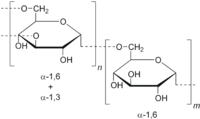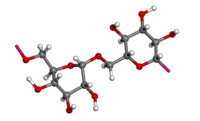Dextran facts for kids
Quick facts for kids Dextran |
|
|---|---|
 |
|
 |
|
| Identifiers | |
| CAS number | |
| KEGG | C00372 |
| Properties | |
| Molecular formula | |
| Molar mass | 0 g mol-1 |
| Pharmacology | |
| ATC code | |
| Except where noted otherwise, data are given for materials in their standard state (at 25 °C, 100 kPa) | |
Dextran is a complex sugar molecule. It is a type of polysaccharide, which means it's made from many smaller glucose units joined together. Dextran was first found in wine.
Scientists define dextrans as branched sugar chains. These chains come from tiny living things like bacteria. They are mostly made of glucose units linked in a special way (C-1 to C-6 bonds). Dextran chains can be very different in size.
The main part of a dextran molecule has a specific type of link between its glucose units. It also has branches that stick out. This branching is what makes dextran different from dextrin. Dextrin is a straight chain of glucose.
Contents
Where Dextran Is Found
Louis Pasteur, a famous scientist, first found dextran. He discovered it as something made by microbes in wine. Later, Allene Jeanes developed a way to make a lot of it using bacteria.
You can also find a lot of dextran in dental plaque. This is the sticky film that forms on your teeth. Dextran can cause problems in sugar factories. It makes sugar solutions thick and can clog pipes.
Today, dextran is made from sucrose (table sugar). It is produced by certain lactic acid bacteria. Examples include Leuconostoc mesenteroides and Streptococcus mutans. The exact structure of the dextran made depends on the type of bacteria.
What Dextran Is Used For
Dextran has many important uses. One type, called Dextran 70, is on the WHO Model List of Essential Medicines. This list includes the most important medicines needed in a health system.
Medical Uses
Dextran is used in medicine in several ways:
- It helps prevent blood clots.
- It makes blood less thick.
- It can increase blood volume in emergencies. This is helpful when someone has lost a lot of blood.
Helping with Blood Clots
Surgeons often use dextran during microsurgery. It helps stop tiny blood vessels from clotting. Dextran works by sticking to red blood cells and platelets. This makes them less sticky and less likely to clump together.
Dextrans also make blood clots easier to break down. This is because they change how clots form. Larger dextran molecules stay in the blood vessels. They pull water into the vessels, which helps increase blood volume. This makes blood flow better and reduces the risk of clots.
Different sizes of dextran are available. Larger dextrans stay in the blood for weeks. This means they have a longer effect on preventing clots. Dextran-40 is a common type used to prevent clotting. About 70% of dextran-40 leaves the body in urine within a day.
Other Medical Uses
- Dextran is used in some eye drops to keep eyes moist.
- It is in some IV fluids. It helps other substances, like iron, dissolve.
- IV solutions with dextran can replace lost blood. They also provide some nutrition. However, they must be used carefully. They don't provide important salts and can cause problems with body chemicals.
- Dextran can also raise blood sugar levels.
Laboratory Uses
Scientists use dextran in many ways in the lab:
- It helps study how water moves in and out of cells.
- It is used in special filters to separate molecules by size.
- Dextran beads can be used in bioreactors.
- It helps attach substances to biosensors.
- Scientists use fluorescent dextran to see parts of cells under a microscope.
- Dextran can coat tiny metal particles. This protects them and makes them safer for use in the body.
- It helps create gradients of molecules for imaging.
- Fluorescent dextran can be used to study how leaky blood vessels are.
- Dextran is used to make tiny carriers for growing cells in labs.
- A special type of dextran is used to study gut diseases in animals.
Possible Side Effects
Dextran usually has few side effects. However, some can be serious. These include:
- Severe allergic reactions (anaphylaxis).
- Too much fluid in the body.
- Fluid in the lungs (pulmonary edema).
- Swelling in the brain (cerebral edema).
- Problems with how platelets work.
A rare but serious side effect is acute kidney injury. This means the kidneys stop working well. Doctors are still debating why this happens. People with diabetes mellitus, kidney disease, or blood vessel problems are more at risk. Some experts suggest avoiding dextran in people with long-term kidney disease.
Research on Dextran
Scientists are working to create new types of dextran. One modified dextran is not soluble in water. But it can dissolve in other liquids. This allows it to be used like other plastics. This new type of dextran is being studied for drug delivery. It has been tested in lab dishes and in animals.
Images for kids
See also
 In Spanish: Dextrano para niños
In Spanish: Dextrano para niños



